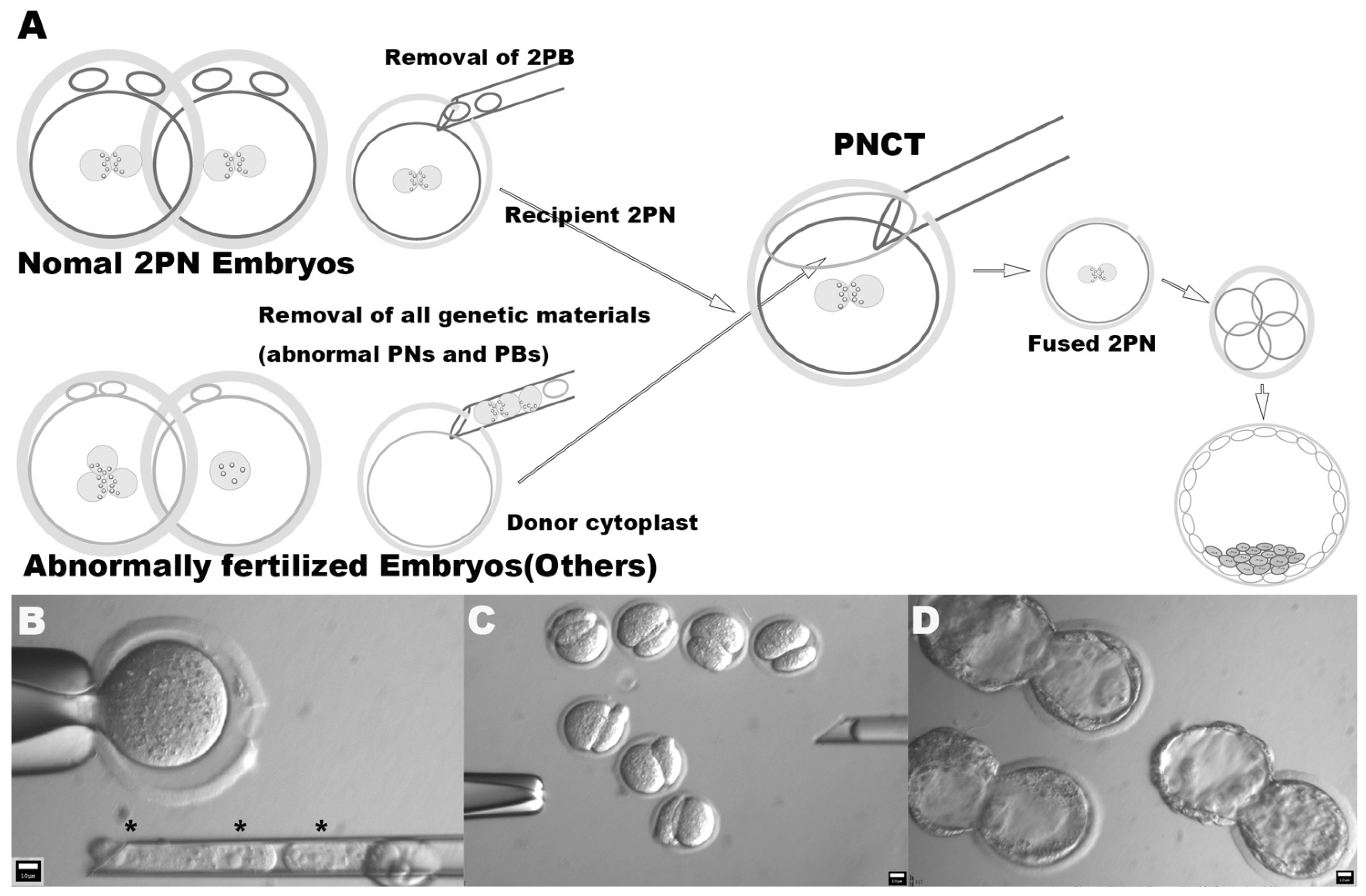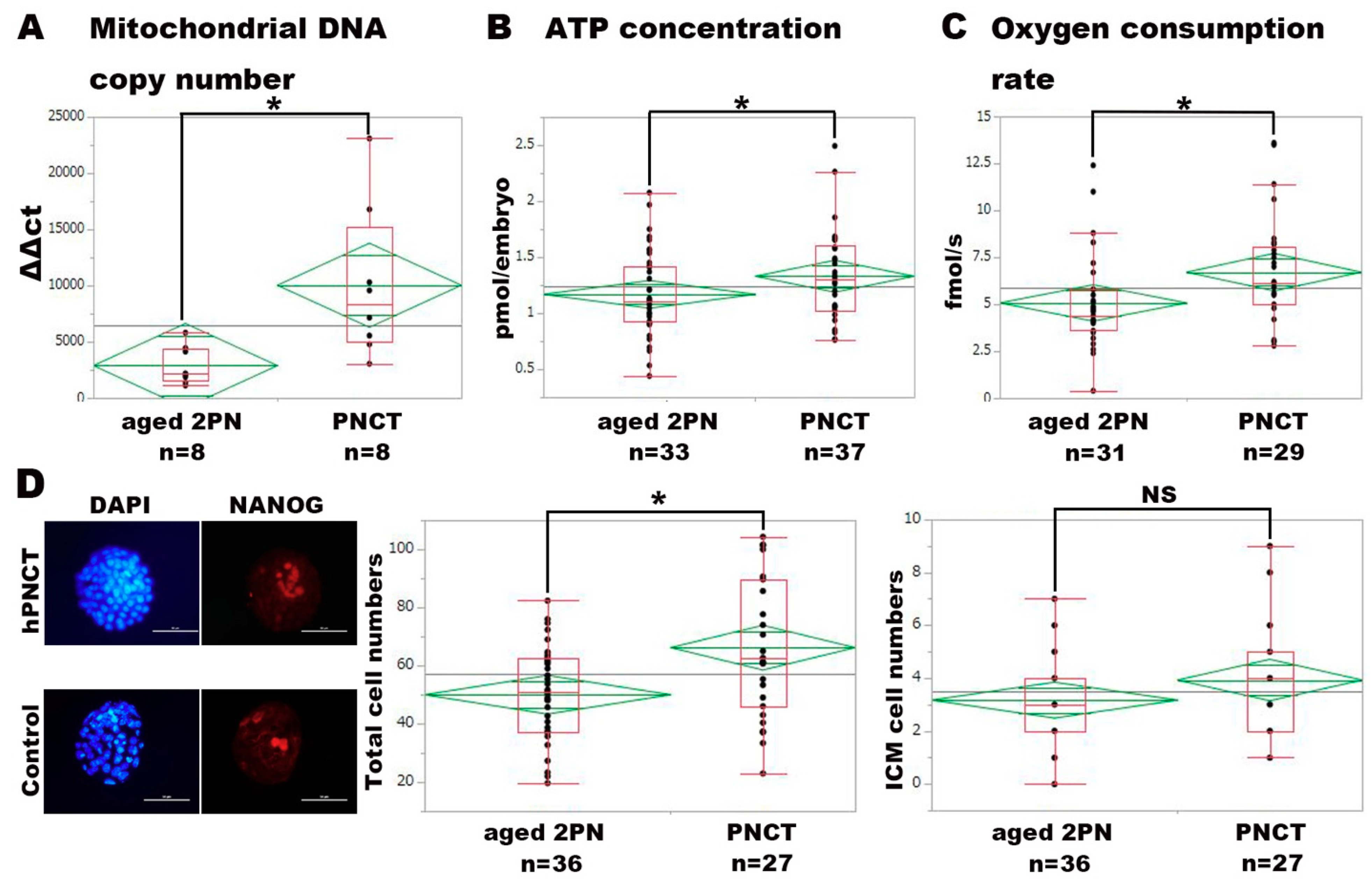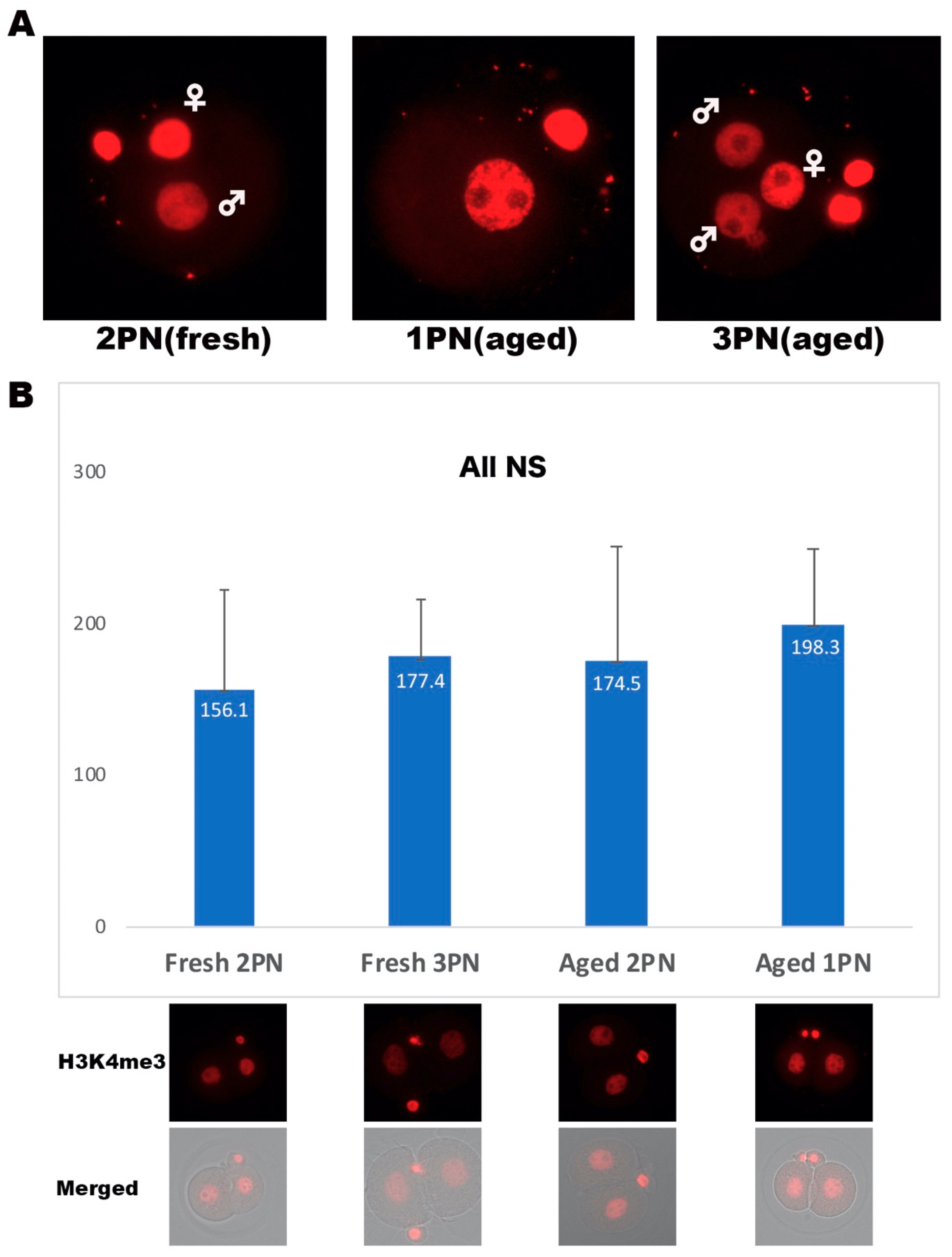Exploration of the Cytoplasmic Function of Abnormally Fertilized Embryos via Novel Pronuclear-Stage Cytoplasmic Transfer
Abstract
1. Introduction
2. Materials and Methods
2.1. Ethical Approval
2.2. Embryos and Mice
2.3. Micromanipulation
2.4. Mitochondrial DNA Copy Number Assay
2.5. Measurement of Adenosine Triphosphate (ATP)
2.6. Measurement of Oxygen Consumption Rate (OCR)
2.7. Immunocytochemical Procedure and Cell Count
2.8. Statistics
3. Results
3.1. Establishment and Verification of Novel Cytoplasmic Transfer
3.2. Exploration of Impact of Transfer of Abnormally Fertilized Cytoplast to Post-Ovulatory “Aged” Mouse Embryos by Pronuclear-Stage Cytoplasmic Transfer
3.3. Verification of Physical Impact of Pronuclear-Stage Cytoplasmic Transfer on Cytoplasmic Function of Mouse Embryos
3.4. Differences in Global Methylation of Abnormally Fertilized Mouse Embryos
4. Discussion
Supplementary Materials
Author Contributions
Funding
Institutional Review Board Statement
Informed Consent Statement
Data Availability Statement
Acknowledgments
Conflicts of Interest
References
- Wolf, D.P.; Mitalipov, N.; Mitalipov, S. Mitochondrial replacement therapy in reproductive medicine. Trends Mol. Med. 2015, 21, 68–76. [Google Scholar] [CrossRef]
- Amleh, A.; Dean, J. Mouse genetics provides insight into folliculogenesis, fertilization and early embryonic development. Hum. Reprod. Update 2002, 8, 395–403. [Google Scholar] [CrossRef]
- De Sousa, P.A.; Watson, A.J.; Schultz, G.A.; Bilodeau-Goeseels, S. Oogenetic and zygotic gene expression directing early bovine embryogenesis: A review. Mol. Reprod. Dev. 1998, 51, 112–121. [Google Scholar] [CrossRef]
- Li, E. Chromatin modification and epigenetic reprogramming in mammalian development. Nat. Rev. Genet. 2002, 3, 662–673. [Google Scholar] [CrossRef] [PubMed]
- Tachibana, M.; Kuno, T.; Yaegashi, N. Mitochondrial replacement therapy and assisted reproductive technology: A paradigm shift toward treatment of genetic diseases in gametes or in early embryos. Reprod. Med. Biol. 2018, 17, 421–433. [Google Scholar] [CrossRef]
- Muggleton-Harris, A.; Whittingham, D.G.; Wilson, L. Cytoplasmic control of preimplantation development in vitro in the mouse. Nature 1982, 299, 460–462. [Google Scholar] [CrossRef]
- Bai, D.; Sun, J.; Jia, Y.; Yin, J.; Zhang, Y.; Li, Y.; Gao, R.; Du, X.; Li, K.; Lin, J.; et al. Genome transfer for the prevention of female infertility caused by maternal gene mutation. J. Genet. Genom. 2020, 47, 311–319. [Google Scholar] [CrossRef] [PubMed]
- Tang, M.; Popovic, M.; Stamatiadis, P.; Van der Jeught, M.; Van Coster, R.; Deforce, D.; De Sutter, P.; Coucke, P.; Menten, B.; Stoop, D.; et al. Germline nuclear transfer in mice may rescue poor embryo development associated with advanced maternal age and early embryo arrest. Hum. Reprod. 2020, 35, 1562–1577. [Google Scholar] [CrossRef] [PubMed]
- Zhang, J.; Wang, C.W.; Krey, L.; Liu, H.; Meng, L.; Blaszczyk, A.; Adler, A.; Grifo, J. In vitro maturation of human preovulatory oocytes reconstructed by germinal vesicle transfer. Fertil. Steril. 1999, 71, 726–731. [Google Scholar] [CrossRef]
- Liu, H.; Lu, Z.; Yang, M.; Liu, Z.; Merhi, Z.; Blazek, J.; Zhang, J. In vitro development of human oocytes reconstructed by sequential transfer of germinal vesicle and MII spindle. Fertil. Steril. 2017, 108, 57–58. [Google Scholar] [CrossRef][Green Version]
- Cohen, J.; Scott, R.; Alikani, M.; Schimmel, T.; Munne, S.; Levron, J.; Wu, L.; Brenner, C.; Warner, C.; Willadsen, S. Ooplasmic transfer in mature human oocytes. Mol. Hum. Reprod. 1998, 4, 269–280. [Google Scholar] [CrossRef]
- Cohen, J.; Scott, R.; Schimmel, T.; Levron, J.; Willadsen, S. Birth of infant after transfer of anucleate donor oocyte cytoplasm into recipient eggs. Lancet 1997, 350, 186–187. [Google Scholar] [CrossRef]
- Tachibana, M.; Amato, P.; Sparman, M.; Woodward, J.; Sanchis, D.M.; Ma, H.; Gutierrez, N.M.; Tippner-Hedges, R.; Kang, E.; Lee, H.S.; et al. Towards germline gene therapy of inherited mitochondrial diseases. Nature 2013, 493, 627–631. [Google Scholar] [CrossRef]
- Zhang, J.; Zhuang, G.; Zeng, Y.; Grifo, J.; Acosta, C.; Shu, Y.; Liu, H. Pregnancy derived from human zygote pronuclear transfer in a patient who had arrested embryos after IVF. Reprod. Biomed. Online 2016, 33, 529–533. [Google Scholar] [CrossRef]
- Mutia, K.; Wiweko, B.; Iffanolida, P.A.; Febri, R.R.; Muna, N.; Riayati, O.; Jasirwan, S.O.; Yuningsih, T.; Mansyur, E.; Hestiantoro, A. The Frequency of Chromosomal Euploidy Among 3PN Embryos. J. Reprod. Infertil. 2019, 20, 127–131. [Google Scholar]
- Reichman, D.E.; Jackson, K.V.; Racowsky, C. Incidence and development of zygotes exhibiting abnormal pronuclear disposition after identification of two pronuclei at the fertilization check. Fertil. Steril. 2010, 94, 965–970. [Google Scholar] [CrossRef] [PubMed]
- Forman, E.J.; Tao, X.; Ferry, K.M.; Taylor, D.; Treff, N.R.; Scott, R.T., Jr. Single embryo transfer with comprehensive chromosome screening results in improved ongoing pregnancy rates and decreased miscarriage rates. Hum. Reprod. 2012, 27, 1217–1222. [Google Scholar] [CrossRef] [PubMed]
- Kimura, Y.; Yanagimachi, R. Intracytoplasmic sperm injection in the mouse. Biol. Reprod. 1995, 52, 709–720. [Google Scholar] [CrossRef] [PubMed]
- Tachibana, M.; Sparman, M.; Mitalipov, S. Chromosome transfer in mature oocytes. Nat. Protoc. 2010, 5, 1138–1147. [Google Scholar] [CrossRef] [PubMed]
- Tachibana, M.; Sparman, M.; Sritanaudomchai, H.; Ma, H.; Clepper, L.; Woodward, J.; Li, Y.; Ramsey, C.; Kolotushkina, O.; Mitalipov, S. Mitochondrial gene replacement in primate offspring and embryonic stem cells. Nature 2009, 461, 367–372. [Google Scholar] [CrossRef] [PubMed]
- Kurosawa, H.; Utsunomiya, H.; Shiga, N.; Takahashi, A.; Ihara, M.; Ishibashi, M.; Nishimoto, M.; Watanabe, Z.; Abe, H.; Kumagai, J.; et al. Development of a new clinically applicable device for embryo evaluation which measures embryo oxygen consumption. Hum. Reprod. 2016, 31, 2321–2330. [Google Scholar] [CrossRef][Green Version]
- Kuno, T.; Tachibana, M.; Fujimine-Sato, A.; Fue, M.; Higashi, K.; Takahashi, A.; Kurosawa, H.; Nishio, K.; Shiga, N.; Watanabe, Z.; et al. A Preclinical Evaluation towards the Clinical Application of Oxygen Consumption Measurement by CERMs by a Mouse Chimera Model. Int. J. Mol. Sci. 2019, 20, 5650. [Google Scholar] [CrossRef]
- Eckstrum, K.; Sprando, R. Semi-automated image acquisition and automatic image quantification methods for liver Organ-Chips. Food Chem. Toxicol. 2021, 151, 112107. [Google Scholar] [CrossRef]
- Felicio, L.S.; Nelson, J.F.; Gosden, R.G.; Finch, C.E. Restoration of ovulatory cycles by young ovarian grafts in aging mice: Potentiation by long-term ovariectomy decreases with age. Proc. Natl. Acad. Sci. USA 1983, 80, 6076–6080. [Google Scholar] [CrossRef]
- Igarashi, H.; Takahashi, T.; Abe, H.; Nakano, H.; Nakajima, O.; Nagase, S. Poor embryo development in post-ovulatory in vivo-aged mouse oocytes is associated with mitochondrial dysfunction, but mitochondrial transfer from somatic cells is not sufficient for rejuvenation. Hum. Reprod. 2016, 31, 2331–2338. [Google Scholar] [CrossRef] [PubMed]
- Smith, A.L.; Lodge, J.R. Interactions of aged gametes: In vitro fertilization using in vitro-aged sperm and in vivo-aged ova in the mouse. Gamete Res. 1987, 16, 47–56. [Google Scholar] [CrossRef] [PubMed]
- Takahashi, T.; Igarashi, H.; Amita, M.; Hara, S.; Matsuo, K.; Kurachi, H. Molecular mechanism of poor embryo development in postovulatory aged oocytes: Mini review. J. Obs. Gynaecol. Res. 2013, 39, 1431–1439. [Google Scholar] [CrossRef] [PubMed]
- Craven, L.; Tuppen, H.A.; Greggains, G.D.; Harbottle, S.J.; Murphy, J.L.; Cree, L.M.; Murdoch, A.P.; Chinnery, P.F.; Taylor, R.W.; Lightowlers, R.N.; et al. Pronuclear transfer in human embryos to prevent transmission of mitochondrial DNA disease. Nature 2010, 465, 82–85. [Google Scholar] [CrossRef] [PubMed]
- McGrath, J.; Solter, D.; Mann, J. Pronuclear Transplantation in the Mouse Embryo. Cold Spring Harb. Protoc. 2017, 2017, pdb.prot094417. [Google Scholar] [CrossRef]
- Siracusa, G.; Whittingham, D.G.; De Felici, M. The effect of microtubule- and microfilament-disrupting drugs on preimplantation mouse embryos. J. Embryol. Exp. Morphol. 1980, 60, 71–82. [Google Scholar] [PubMed]
- Zhang, J.; Liu, H.; Luo, S.; Lu, Z.; Chavez-Badiola, A.; Liu, Z.; Yang, M.; Merhi, Z.; Silber, S.J.; Munne, S.; et al. Live birth derived from oocyte spindle transfer to prevent mitochondrial disease. Reprod. Biomed. Online 2017, 34, 361–368. [Google Scholar] [CrossRef] [PubMed]
- Hyslop, L.A.; Blakeley, P.; Craven, L.; Richardson, J.; Fogarty, N.M.; Fragouli, E.; Lamb, M.; Wamaitha, S.E.; Prathalingam, N.; Zhang, Q.; et al. Towards clinical application of pronuclear transfer to prevent mitochondrial DNA disease. Nature 2016, 534, 383–386. [Google Scholar] [CrossRef] [PubMed]
- Lee, H.-S.; Ma, H.; Juanes, C.R.; Tachibana, M.; Sparman, M.; Woodward, J.; Ramsey, C.; Xu, J.; Kang, E.-J.; Amato, P.; et al. Rapid Mitochondrial DNA Segregation in Primate Preimplantation Embryos Precedes Somatic and Germline Bottleneck. Cell Rep. 2012, 1, 10. [Google Scholar] [CrossRef]
- Wang, T.; Sha, H.; Ji, D.; Zhang, H.L.; Chen, D.; Cao, Y.; Zhu, J. Polar body genome transfer for preventing the transmission of inherited mitochondrial diseases. Cell 2014, 157, 1591–1604. [Google Scholar] [CrossRef] [PubMed]
- Huang, C.C.; Cheng, T.C.; Chang, H.H.; Chang, C.C.; Chen, C.I.; Liu, J.; Lee, M.S. Birth after the injection of sperm and the cytoplasm of tripronucleate zygotes into metaphase II oocytes in patients with repeated implantation failure after assisted fertilization procedures. Fertil. Steril. 1999, 72, 702–706. [Google Scholar] [CrossRef]
- Staessen, C.; Janssenswillen, C.; Devroey, P.; Van Steirteghem, A.C. Cytogenetic and morphological observations of single pronucleated human oocytes after in-vitro fertilization. Hum. Reprod. 1993, 8, 221–223. [Google Scholar] [CrossRef]
- Capalbo, A.; Treff, N.; Cimadomo, D.; Tao, X.; Ferrero, S.; Vaiarelli, A.; Colamaria, S.; Maggiulli, R.; Orlando, G.; Scarica, C.; et al. Abnormally fertilized oocytes can result in healthy live births: Improved genetic technologies for preimplantation genetic testing can be used to rescue viable embryos in in vitro fertilization cycles. Fertil. Steril. 2017, 108, 1007–1015.e3. [Google Scholar] [CrossRef] [PubMed]
- Feng, H.; Hershlag, A. Fertilization abnormalities following human in vitro fertilization and intracytoplasmic sperm injection. Microsc. Res. Tech. 2003, 61, 358–361. [Google Scholar] [CrossRef]
- Lord, T.; Nixon, B.; Jones, K.T.; Aitken, R.J. Melatonin prevents postovulatory oocyte aging in the mouse and extends the window for optimal fertilization in vitro. Biol. Reprod. 2013, 88, 67. [Google Scholar] [CrossRef]
- Prasad, S.; Koch, B.; Chaube, S.K. Maturation promoting factor destabilization facilitates postovulatory aging-mediated abortive spontaneous egg activation in rat. Dev. Growth Differ. 2016, 58, 293–302. [Google Scholar] [CrossRef]
- Ito, J.; Shimada, M.; Terada, T. Mitogen-activated protein kinase kinase inhibitor suppresses cyclin B1 synthesis and reactivation of p34cdc2 kinase, which improves pronuclear formation rate in matured porcine oocytes activated by Ca2+ ionophore. Biol. Reprod. 2004, 70, 797–804. [Google Scholar] [CrossRef][Green Version]
- Sergeev, I.N.; Norman, A.W. Calcium as a mediator of apoptosis in bovine oocytes and preimplantation embryos. Endocrine 2003, 22, 169–175. [Google Scholar] [CrossRef]
- Combelles, C.M.; Kearns, W.G.; Fox, J.H.; Racowsky, C. Cellular and genetic analysis of oocytes and embryos in a human case of spontaneous oocyte activation. Hum. Reprod. 2011, 26, 545–552. [Google Scholar] [CrossRef]
- Lu, Q.; Chen, Z.J.; Gao, X.; Ma, S.Y.; Li, M.; Hu, J.M.; Li, Y. Oocyte activation with calcium ionophore A23187 and puromycin on human oocytes that fail to fertilize after intracytoplasmic sperm injection. Zhonghua Fu Chan Ke Za Zhi 2006, 41, 182–185. [Google Scholar] [PubMed]
- King, W.A.; Xu, K.P.; Sirard, M.A.; Greve, T.; Leclerc, P.; Lambert, R.D.; Jacques, P. Cytogenetic study of parthenogenetically activated bovine oocytes matured in vivo and in vitro. Gamete Res. 1988, 20, 265–274. [Google Scholar] [CrossRef] [PubMed]
- Pathak, J.; Kharche, S.D.; Goel, A. Effects of different activation protocols on cleavage rate and blastocyst production of caprine oocytes. Iran. J. Vet. Res. 2017, 18, 243–248. [Google Scholar] [PubMed]
- Hajkova, P. Epigenetic reprogramming in the germline: Towards the ground state of the epigenome. Philos. Trans. R. Soc. Lond. B Biol. Sci. 2011, 366, 2266–2273. [Google Scholar] [CrossRef] [PubMed]
- Dahl, J.A.; Jung, I.; Aanes, H.; Greggains, G.D.; Manaf, A.; Lerdrup, M.; Li, G.; Kuan, S.; Li, B.; Lee, A.Y.; et al. Broad histone H3K4me3 domains in mouse oocytes modulate maternal-to-zygotic transition. Nature 2016, 537, 548–552. [Google Scholar] [CrossRef] [PubMed]
- Seisenberger, S.; Peat, J.R.; Hore, T.A.; Santos, F.; Dean, W.; Reik, W. Reprogramming DNA methylation in the mammalian life cycle: Building and breaking epigenetic barriers. Philos. Trans. R. Soc. Lond. B Biol. Sci. 2013, 368, 20110330. [Google Scholar] [CrossRef] [PubMed]
- Liu, X.; Luo, C.; Deng, K.; Wu, Z.; Wei, Y.; Jiang, J.; Lu, F.; Shi, D. Cytoplasmic volume of recipient oocytes affects the nucleus reprogramming and the developmental competence of HMC buffalo (Bubalus bubalis) embryos. J. Vet. Med. Sci. 2018, 80, 1291–1300. [Google Scholar] [CrossRef]
- Cheng, Y.; Wang, K.; Kellam, L.D.; Lee, Y.S.; Liang, C.G.; Han, Z.; Mtango, N.R.; Latham, K.E. Effects of ooplasm manipulation on DNA methylation and growth of progeny in mice. Biol. Reprod. 2009, 80, 464–472. [Google Scholar] [CrossRef] [PubMed]
- Ramalho-Santos, J.; Varum, S.; Amaral, S.; Mota, P.C.; Sousa, A.P.; Amaral, A. Mitochondrial functionality in reproduction: From gonads and gametes to embryos and embryonic stem cells. Hum. Reprod. Update 2009, 15, 553–572. [Google Scholar] [CrossRef]
- Veatch, J.R.; McMurray, M.A.; Nelson, Z.W.; Gottschling, D.E. Mitochondrial dysfunction leads to nuclear genome instability via an iron-sulfur cluster defect. Cell 2009, 137, 1247–1258. [Google Scholar] [CrossRef] [PubMed]
- Wallace, D.C.; Fan, W. Energetics, epigenetics, mitochondrial genetics. Mitochondrion 2010, 10, 12–31. [Google Scholar] [CrossRef] [PubMed]
- Ma, H.; Van Dyken, C.; Darby, H.; Mikhalchenko, A.; Marti-Gutierrez, N.; Koski, A.; Liang, D.; Li, Y.; Tippner-Hedges, R.; Kang, E.; et al. Germline transmission of donor, maternal and paternal mtDNA in primates. Hum. Reprod. 2021, 36, 493–505. [Google Scholar] [CrossRef] [PubMed]




| Rep # | Recipient Embryo | Donor Cytoplast | # of Embryos Used | 2-Cell (%) | Blastocysts (%) | |
|---|---|---|---|---|---|---|
| Aged 2PN | 10 | NA | NA | 223 | 220 (98.7) | 135 (60.5) a |
| Fresh 2PN | 10 | NA | NA | 300 | 294(98.0) | 257(85.7) b |
| PNCT with 1PN | 8 | “aged” 2PN | “aged” 1PN (aPNCT) | 123 | 101(82.1) † | 48(39.0) c † |
| 11 | “fresh” 1PN (hPNCT) | 153 | 136 (88.9) | 46 (30.0) c † | ||
| PNCT with 3PN | 7 | “aged” 3PN (aPNCT) | 83 | 71(85.5) | 55(66.3) ‡ | |
| 11 | “fresh” 3PN (hPNCT) | 142 | 139 (97.9) ‡ | 115 (81.0) b ‡ |
Publisher’s Note: MDPI stays neutral with regard to jurisdictional claims in published maps and institutional affiliations. |
© 2021 by the authors. Licensee MDPI, Basel, Switzerland. This article is an open access article distributed under the terms and conditions of the Creative Commons Attribution (CC BY) license (https://creativecommons.org/licenses/by/4.0/).
Share and Cite
Fujimine-Sato, A.; Kuno, T.; Higashi, K.; Sugawara, A.; Hiraga, H.; Takahashi, A.; Tanaka, K.; Yokoyama, E.; Shiga, N.; Watanabe, Z.; et al. Exploration of the Cytoplasmic Function of Abnormally Fertilized Embryos via Novel Pronuclear-Stage Cytoplasmic Transfer. Int. J. Mol. Sci. 2021, 22, 8765. https://doi.org/10.3390/ijms22168765
Fujimine-Sato A, Kuno T, Higashi K, Sugawara A, Hiraga H, Takahashi A, Tanaka K, Yokoyama E, Shiga N, Watanabe Z, et al. Exploration of the Cytoplasmic Function of Abnormally Fertilized Embryos via Novel Pronuclear-Stage Cytoplasmic Transfer. International Journal of Molecular Sciences. 2021; 22(16):8765. https://doi.org/10.3390/ijms22168765
Chicago/Turabian StyleFujimine-Sato, Ayako, Takashi Kuno, Keiko Higashi, Atsushi Sugawara, Hiroaki Hiraga, Aiko Takahashi, Keiko Tanaka, Emi Yokoyama, Naomi Shiga, Zen Watanabe, and et al. 2021. "Exploration of the Cytoplasmic Function of Abnormally Fertilized Embryos via Novel Pronuclear-Stage Cytoplasmic Transfer" International Journal of Molecular Sciences 22, no. 16: 8765. https://doi.org/10.3390/ijms22168765
APA StyleFujimine-Sato, A., Kuno, T., Higashi, K., Sugawara, A., Hiraga, H., Takahashi, A., Tanaka, K., Yokoyama, E., Shiga, N., Watanabe, Z., Yaegashi, N., & Tachibana, M. (2021). Exploration of the Cytoplasmic Function of Abnormally Fertilized Embryos via Novel Pronuclear-Stage Cytoplasmic Transfer. International Journal of Molecular Sciences, 22(16), 8765. https://doi.org/10.3390/ijms22168765






